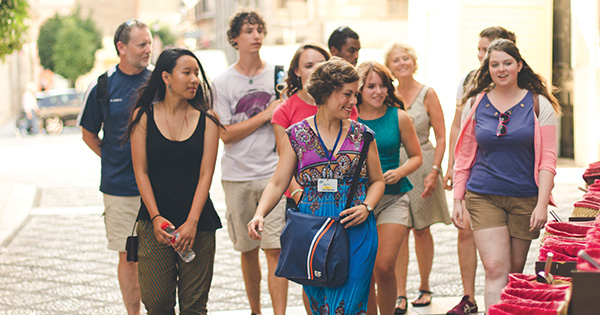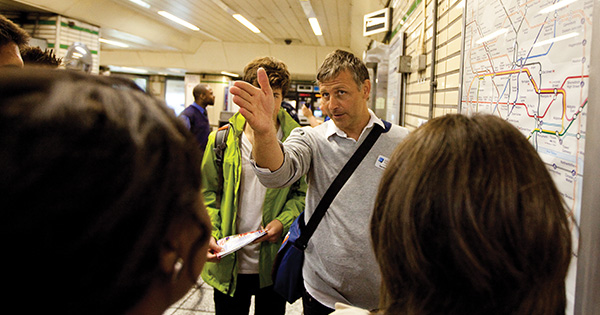Bobby is a Principal with a background in History and Social Studies. He first traveled with EF Educational Tours in 2010 to Rome and Paris, and now leads a student tour every summer. He believes that young people should experience life outside of their communities, and that understanding other cultures is imperative to solving global challenges.
If you are leading a tour this summer then you are officially in the homestretch. The countless hours you’ve devoted to meeting with your students and fundraising, is about to pay off! As you and your group charge down the final stretch of your trip your Tour Consultant will be reminding you about rooming lists, passports and debit cards, but I’ve learned that it’s equally important to make sure that your students understand what it’s like to travel abroad. Below I’ve listed the top four places where I think it is vitally important that student travelers are prepared. 
Cruising comfortably at 30,000 feet
First of all, be sure that your travelers understand that they will be on a plane for anywhere from 5-9 hours (depending on your flight origin and destination), and thus, should plan accordingly. While nearly all international flights provide free in-flight movies, it’s a good idea to have a book, iPad, or other device to help pass the time. It’s also important that they understand they’re likely to be a little cramped and they are going to have to sleep in an “upright” position, so dress in comfortable clothing. Despite these small inconveniences, flying is one of my favorite parts of any tour; the in-flight meals are generally pretty decent and the entertainment and Wi-Fi options are continually improving. If they do not think they’re going to enjoy the food on the plane then make sure they bring some snacks for themselves. Making sure that your students know what to expect during the flight will help start your trip off on the right foot.
That awful thing called jet lag
This is closely connected with setting expectations for your group’s flight. If your trip takes you to Europe, hopefully you’ve explained the whole rotation of the earth and time zone thing. If not, plan a meeting and do it right now. For example, when your plane touches down in Heathrow from the Midwest, your body is going to crave sleep. Your body clock will think it is Midnight, but it will be 7:00 AM in London—time to rise and shine and enjoy a bacon butty. This, my friends is what we call jet lag. Simply put, your travelers need to be aware that they will be extremely tired the first day and will have to fight the desire to nap. However, the good news is that if they can manage to stay awake until bedtime, by the next morning their bodies will be almost fully adjusted.
A place to rest
One of the most charming aspects of travel in Europe is the hotels. I always tell my travelers that if they are expecting an Americanized, cookie-cutter hotel with a heated pool, workout room and free Wi-Fi, then we can all stay together in the hotel a few blocks from our school. These buildings were often once used for something else. They are very much part of the city’s history and that uniqueness should be appreciated. There are far fewer hotels that are built simply for the purpose of being a hotel, making the lobby and interior a fun experience. It’s important to let your travelers know that European hotel rooms tend to be smaller and are often relatively simple in their décor. The Wi-Fi, while increasingly faster, can oftentimes be spotty. Breakfast in Europe is not the same spread of waffles, doughnuts, eggs and bacon that you might find in the States. Finally, remind your travelers that your hotel is to serve as a clean, safe place to rest and that you will be spending most of your day adventurously exploring some of the most beautiful and historic cities in the world.
Walk this way
Public transport in Europe is readily available throughout the continent. Your tour will undoubtedly include trips on the local metro, bus, train and perhaps a ferry. You can easily move between sites in almost every major city in this fashion. However, it’s important to keep in mind that the cities you are visiting are large and that a good distance often separates one site from the next. For example, in the Vatican you can remind your students that they are actually walking through an entire country (albeit the smallest in the world). The nave in St. Peter’s basilica is over two football fields long! It’s important your travelers bring comfortable walking shoes. Your journey will often take you past some of the most breathtaking sites in the world, so it’s important that you’re comfortable and fully take advantage of the experience. Plus, all the walking will help burn some extra calories, so that means you can enjoy another gelato after dinner.
As your departure date nears, it is the perfect time to remind your students of what to expect while traveling abroad. Your tour will be a life-changing experience for both you as a Group Leader, and for your students. You want to ensure that your group makes the most of their trip by knowing what to expect, and understanding what it means to be a good traveler.
For more travel advice, including packing and travel documents, visit eftours.com/tour-preparation
Related articles
